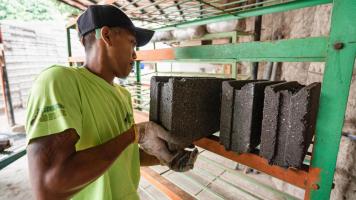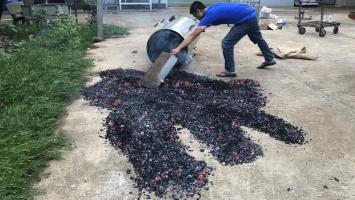Bamboo has many uses, especially in rural areas where it serves as fuel, housing and furniture material, and even food. Photo credit: ADB.
Multisectoral initiatives are deploying bamboo-based solutions to strengthen ecosystem and community resilience and achieve sustainability goals.
Planting more bamboo can help save the planet. Research shows the fast-growing grass absorbs more carbon than most trees. It is climate-resilient and can be planted on degraded land and steep slopes to help restore forests and reduce soil erosion and runoff. Its many and new uses offer broad socioeconomic benefits, particularly in rural areas where it serves as food (bamboo shoots), fuel, and housing material, and supports livelihoods.
Global demand for bamboo is increasing with new technology and applications making it a suitable and sustainable alternative to wood in such industries as paper, textile, furniture, and construction. Engineered bamboo now has higher strength to weight ratio than steel and higher compression value than concrete. Bamboo biomass, known as “green gasoline,” is also considered as a potential renewable energy source.
The global bamboo market is expected to reach $92.62 billion by 2027 from $71.60 billion in 2023. However, there is not enough supply of quality bamboo in the global market. Farmers lack know-how in proper bamboo propagation and management and lack market access and financing. There is also a dearth of reliable data on bamboo resources, such as raw materials inventory and species distribution and diversity.
Multisectoral initiatives have been launched to address these challenges and harness the potential of bamboo for climate mitigation and adaptation, ecosystem restoration, and poverty reduction.
Developing the bamboo value chain
Indigenous peoples and farmers play a crucial role in bamboo propagation by managing bamboo stands and integrating traditional knowledge with modern techniques for sustainable production.
ADB is collaborating with experts from different fields and stakeholders, including indigenous peoples, to develop scalable and investment-ready solutions to support sustainable bamboo value chains in Asia. Ideas and insights from a series of workshops laid the groundwork for pilot projects that demonstrate bamboo agroforestry as a secure, bankable, and tradable asset through the use of fintech, geospatial technology, and artificial intelligence. The key is to empower bamboo farmers with tools to assess the value of their crops in real time, predict yields and income, and provide verifiable data to lenders and potential investors to facilitate financing and investments. Tech solutions also open opportunities for earning carbon credits from growing bamboo. Successful pilots will be replicated in countries across the region.
In the Philippines, ADB is working with the public and private sectors on digital solutions that trace an income stream to an identified cluster of bamboo that is verifiably linked to the farmer. Bamboo plants are geotagged in designated sites in the country to monitor their growth.
On 18 September, World Bamboo Day, this year, ADB launched Farmer360, the world’s first blockchain-powered digital bamboo supply chain platform, in partnership with the Philippine Bamboo Industry Development Council. Developed under a technical assistance project, the platform provides end-to-end traceability and digital monitoring, reporting, and verification. It is being pilot tested by smallholder farmers, suppliers, and Rizome Philippines, which produces engineered bamboo products and has a Verra-certified carbon farming project in Mindanao.
Farmer360 is expected to boost farmers’ incomes and may further be developed to issued tokenized carbon credits.
The ADB project is also supporting policy design and regulatory reforms to develop the bamboo industry and supply chain in the country. The Philippines is a leading bamboo exporter but needs to shift to high-value exports. The native giant bamboo is highly suitable for making engineered bamboo, paper, textile, and biofuel.
Mapping resources in Asia
According to the Food and Agriculture Organization of the United Nations (FAO), Asia accounts for an estimated 71% of global bamboo. However, it is difficult to map bamboo in the region because of its “complex terrain, diverse landscapes, and limited ground-truth data.” Bamboo stands grow wild in forests and backyards but may not be fit for commercial use.
FAO has developed a simple and scalable approach to mapping bamboo in Asia using freely available satellite imagery and open-source solutions. Bamboo resources in three countries, Bangladesh, Myanmar, and Thailand, were mapped using cloud-computing tools, including FAO's System for Earth Observation Data Access, Processing and Analysis for Land Monitoring (SEPAL) and Google Earth Engine (GEE).
Implemented in partnership with the International Bamboo and Rattan Organization (INBAR), the project seeks to support evidence-based policy development and bamboo resource management. The goal is to enable the region to develop the full potential of bamboo for poverty reduction, carbon sequestration, land restoration, and green construction.
Building a global ecosystem
The United Nations Framework Convention on Climate Change (UNFCCC) and INBAR launched BambooBoost at COP29 in November 2024. It is a multi-dimensional, inclusive, and innovation-driven initiative that “leverages bamboo’s unique potential as a nature-based solution to accelerate climate action, enhance biodiversity conservation, and strengthen ecosystem and community resilience.” It will help countries integrate bamboo-based approaches into national climate strategies and development planning and promote collaboration between governments, communities, financiers, and innovators.
Action plans include encouraging bamboo-based products as an alternative to plastic, cement, and steel; supporting bamboo agroforestry for ecosystem restoration and land rehabilitation; promoting bamboo innovation, inclusive business models, and sustainable livelihoods; and improving access to market and finance.
As COP30 approaches this November, Bambooboost will start “building a global bamboo ecosystem that delivers high-impact solutions across adaptation, mitigation, and sustainable development.” This entails sharing good practices and innovations, building capacity, developing technical guidance and tools, mobilizing finance, exploring market and non-market approaches, and policy advocacy and stakeholder engagement.


